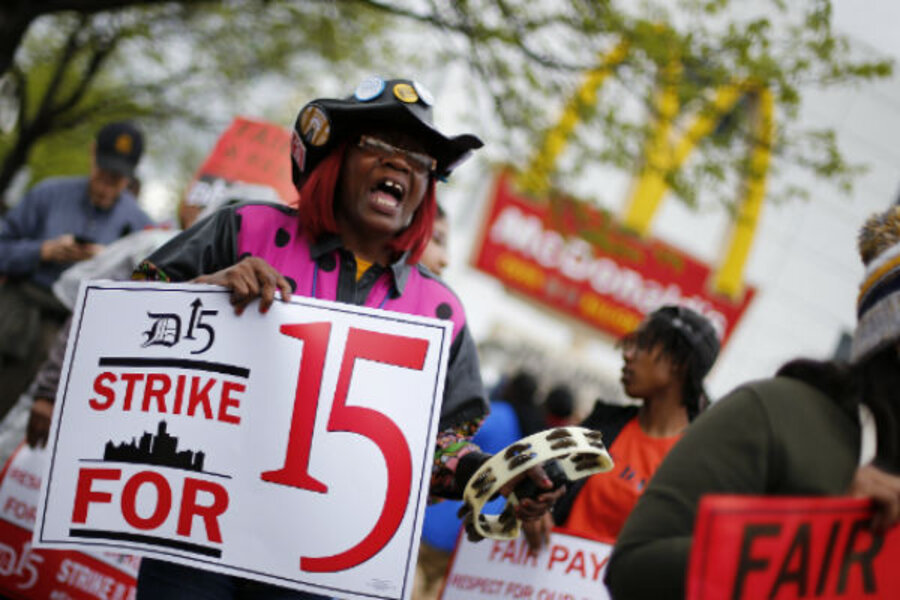Fast-food wage dispute: How are teens part of the discussion?
Loading...
As fast food workers in about 150 US cities prepare to engage in acts of civil disobedience in an effort to drive up wages, parents have a drive-thru window of opportunity to educate working students by talking about how they are being treated by employers and discuss ways to effect change.
Labor organizers with the group Fast Food Forward are expected to escalate their campaign to unionize the industry's workers on Thursday, according to the Associated Press.
It’s hard to say what unionization will bring to fast food workers, In some cases, a higher wage under unionization could also lead to union dues cutting into wages, including those for part-time workers, as some have seen in the other industries.
Therefore I will leave the in-depth industry analysis on how unionizing might affect part-time, student workers, to the experts and focus instead on what my family has experienced with unions and the lack thereof.
While the Fast Food Forward initiative seems more focused on full-time employees, versus teens and college-age employees working part-time, many parents may see this as an opportunity to discuss this news with their working students in order to help them understand the role of civil-disobedience protests and unions in the workplace.
Two of my sons, ages 19 and 20, work year-round, part-time, in minimum-wage positions. According to a 2013 study by The Center for Economic and Policy Research (CEPR), which promotes debate on economic and social issues, my sons are not alone, since about 30 percent of fast-food employees in America are teens.
In 2013, there were 3,653,168 fast-food restaurant employees (teen and adult) in the US, according to the website Statista.
While that teen percentage may be significantly lower than some people expected, it’s still more than a million teens. Another 30 percent of fast-food workers are of college age, 20-24, with the remaining 40 percent being 25 or older, according to CEPR’s 2013 data.
To parents of teens and college students, that is just over 2 million of our “kids” affected by low wages.
Seeing this story brought back one of my own that I had buried deep and never told my own sons, but now realize I should have.
When I was 17-years-old, living in Oakhurst, N.J., I worked for a year as a counter person at a local McDonald's, which was a minimum- wage position.
When I graduated high school early and enrolled at a local college, I needed to quit my part-time job.
The owner of that particular store, while very driven, had a bad habit of berating his employees at the top of his voice in front of customers and other staff. To this day, I remember what the owner said when I handed-in my two-weeks notice.
“You could work your way up here and make something of yourself,” the owner said. “If you leave you will never make anything out of your life! You’ll never amount to anything. You’ll be a loser!”
I went home and cried until my grandmother, who lived with us, set me straight.
My grandmother was Anna Kapinos, a retired union leader from Passaic, N.J., and a key member of the ILGWU (International Ladies Garment Workers Union) there for decades.
It was not uncommon to hear my grandmother’s reedy voice singing the jingle “Look for the Union Label” that was made popular in the 1978 ILGWU commercial touting the value of union-made goods.
Grandma Annie sat me down and told me all about what it had been like working in the garment factory before the union came along and recruited her to be an organizer.
She found that there was strength in numbers, even when the numbers were composed of people who were afraid.
Thanks to non-violent protests such as strikes, walkouts, and picketing, Grandma and many others made a big difference in the way workers were treated.
While she didn’t expect me to unionize the Oakhurst McDonald's, she did make me “march” right back over there to face the owner and stand up for myself because she knew that if I didn’t, I might lose my self-esteem and confidence.
Because I’d called to make an appointment (on grandma’s advice), the owner stood at the door, grinning like a happy cat looking forward to swallowing this canary. Apparently, he thought I was coming to beg for my job back.
In front of all the patrons and my former co-workers he announced that I had something to tell them all.
I wanted to run away, but the thought of my grandmother rooted me to the spot.
Instead, I told the impromptu audience about how demeaning it had been to work for someone who treated people so badly and paid them less than they were worth.
I closed by saying that leaving that job in order to go to college did not make me a “loser.” The only thing that could make that a true statement would be me believing it. The owner completely lost his temper, swearing a blue streak. As a result the place emptied of patrons who – I fantasized – would never return.
I sang the “Union Label” song all the way home.
Perhaps, given the current efforts to unionize fast-food chains, it’s time for parents to ask our teens and college students about how their minimum-wage experiences are treating them. Would a $15 minimum wage mean more money in their pockets or fewer jobs available to them? Would they (or their parents) be willing to spend more on burgers and fries to cover the higher wages?
In our house, thanks to Grandma Annie, the message will be that there’s strength in numbers, even if it’s only adding one parent to the list of people who are there to support them.








